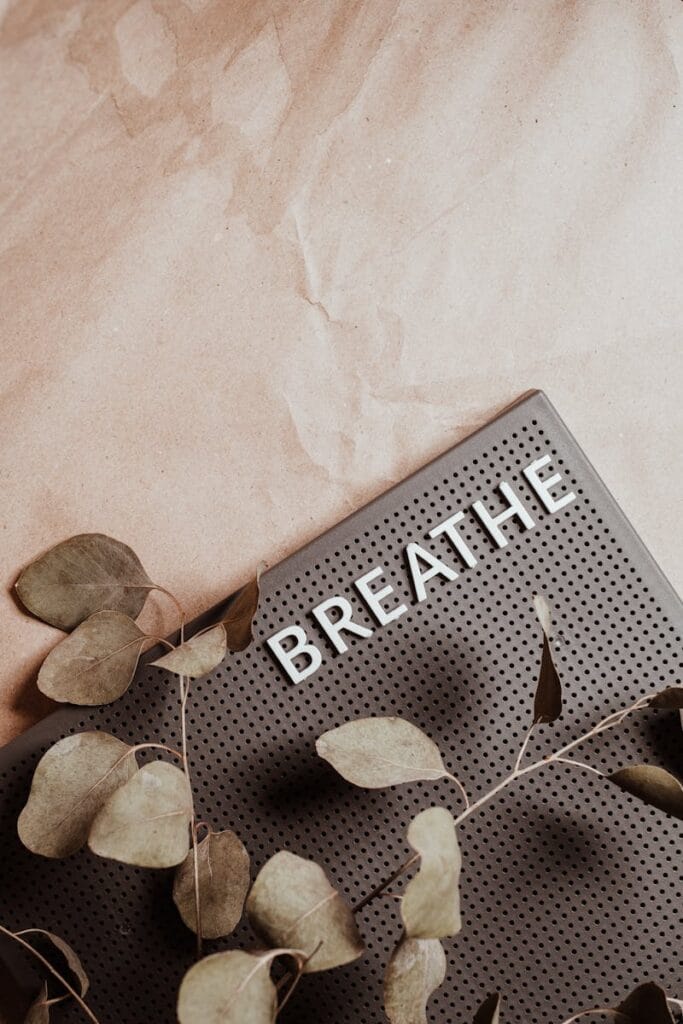Your tolerance to carbon dioxide determines
when you feel the urge to breathe.
We must breathe to get rid of excess carbon dioxide produced during cellular metabolism. However, we also need to keep some carbon dioxide in our lungs and blood so that our red blood cells are able to let go of oxygen and oxygenate our body. Our bodies adapt to different levels of carbon dioxide over time and this shifts when we have the feeling or desire to breathe.
Carbon dioxide is produced by our cells when they convert food into energy. The atmosphere has roughly 0.04% carbon dioxide in it. Yet, ideally the air in our lungs would contain 5-7% carbon dioxide. This 5-7% build up of carbon dioxide comes from our bodies, not from the outside air. We need to maintain some of our carbon dioxide that we produce so that our red blood cells are able to release oxygen into our cell tissues through a process called the Bohr effect and our blood pH is maintained.
Someone who’s having a panic attack or is hyperventilating is breathing too much. This person is not allowing the carbon dioxide to build up in their lungs so that the oxygen can be released from their blood into their cell tissues. They feel like they’re not able to breathe. Historically, we’ve handed this person a paper bag so that they can breathe into and out of the bag, steadily increasing the amount of carbon dioxide that’s in their lungs.
Looking at the other end of sensitivity, mountain climbers who able to climb Mt. Everest without oxygen support tend to have a slower resting respiratory rate and a higher tolerance to carbon dioxide. With a higher tolerance to carbon dioxide, your body is better able to get whatever oxygen is in the blood to the cell tissues.
In general you will have greater endurance and respiratory stamina if you have a higher tolerance to carbon dioxide. Most of us have a carbon dioxide tolerance somewhere in between the individual who frequently hyperventilates and the practiced mountain climbing athlete. Our tolerance to carbon dioxide is impacted by our habits, our stress levels, how much we talk, and our lived experiences. We have some chemical receptors that measure the amount of carbon dioxide in our blood; these receptors send the signal to our brain that we need to breathe.
The beautiful thing about our bodies is that they’re incredibly adaptable. Our habits, lifestyle, and emotions will determine whether our carbon dioxide sensitivity increases or decreases in the future. When we breathe in and out through our nose, rather than our mouth, we’re bringing in smaller amounts of outside air which allows our carbon dioxide levels to build up slightly and stay a little higher. If we always breathe in and out through the mouth, we’ll be bringing in more outside air and on average have a lower level of carbon dioxide in our lungs and blood.
Through intentional breathing exercises and practice, someone’s tolerance to carbon dioxide can change over time. One of the best exercises to do is to breathe through your nose as much as possible when you’re resting, exercising, or sleeping. You could even try to breathe through your nose while talking. You’ll need to talk a little slower, pause to inhale through your nose, and then resume speaking as you exhale through the mouth. After you’re an experienced nose breather, you could soften your breath, inhaling slightly smaller breaths at a slightly slower cadence.
There are many ways to measure your tolerance to carbon dioxide. The three most common are listed below. Try them and see how you do.
- Maximum number of steps you are able to take after your normal exhale before you must inhale.
- Results typically vary from 10-120 steps.
- Many people are able to do 40-50 steps.
- Ideally from a breathing efficiency perspective, you would be able to take 80+ steps.
- There could be many reasons why the number of steps you take is different than this. Don’t panic, just breathe a nice soft and steady breath in and out through the nose.
- BOLT (Body Oxygen Level Test) score or the Control Pause (CP): Amount of time you can hold your breath out after a normal exhale before your first real urge to breathe. You should be able to breathe in normally through your nose afterwards and then repeat after resting a couple breaths and get the same result.
- Results typically vary from 5-40 seconds.
- Many people are able to do 20 seconds.
- Ideally from a breathing efficiency standpoint, you would have a score of 25+ seconds.
- There could be many reasons why the number of seconds you can pause after your exhale is different than this. Don’t panic, just breathe a nice soft and steady breath in and out through the nose.
- Amount of time you can slowly extend your exhale before you inhale. After a large inhale, how many seconds can you exhale?
- Results typically vary from 5-90 seconds.
- Many people are able to do 20-40 seconds.
- Ideally from a breathing efficiency perspective, you would be able to slowly extend your exhale for 50+ seconds.
- There could be many reasons why the number of seconds you can extend your exhale and pause before your inhale is different than this. Don’t panic, just breathe a nice soft and steady breath in and out through the nose.
If you want to learn more or practice some exercises to adjust your carbon dioxide sensitivity, take a class, schedule a private, or reach out to Nicole.
Some techniques you can do now to increase your carbon dioxide tolerance are the following:
- Try to breathe through your nose more often, including when you’re doing some physical activity.
- Be mindful of the quantity of air you’re breathing, breathe in only the amount of air you need, not more.
- You could also practice doing the first measurement assessment: Take as many steps as you comfortably can, after you’ve exhaled. When you need to breathe again, make sure you breathe in through your nose, recover, and then repeat 5-8 times/day.

